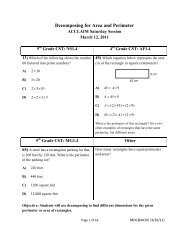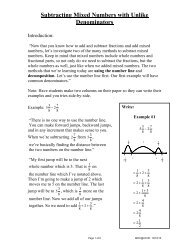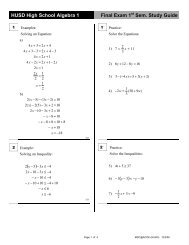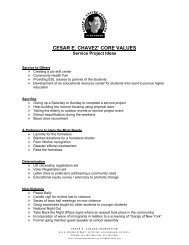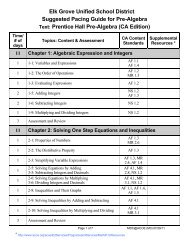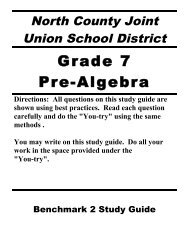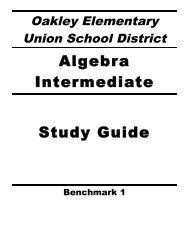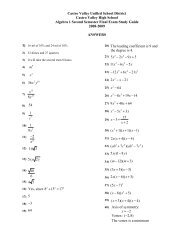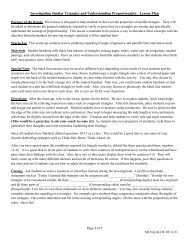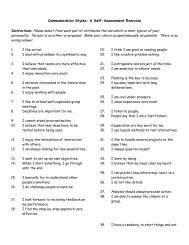SGUSD Algebra I Semester 2 Study Guide 2009-10
SGUSD Algebra I Semester 2 Study Guide 2009-10
SGUSD Algebra I Semester 2 Study Guide 2009-10
You also want an ePaper? Increase the reach of your titles
YUMPU automatically turns print PDFs into web optimized ePapers that Google loves.
Sunol Glen Unified School District<strong>Algebra</strong> 1Second <strong>Semester</strong> <strong>Study</strong> <strong>Guide</strong>• FunctionsExample 1) Find the domain and range for the setof ordered pairs. Then tell if the relation is afunction.Domain: {–5, 8, 1}Range: {3, –2, –4, 1}This is not a function since the x-coordinate –5 ispaired with two different y-coordinates.Example 2) Find the range fordomain is {–2, 0, 1 }xy–2 70 31 1Range: {7, 3, 1}given the1) Find the domain and range for the givenrelation.2) Find the range for given thedomain is {-2, -1, 0, 1, 2}• Slope of a lineExample 1) Find the slope of the line through thepoints (8, –2) and (–2, 2)Example 2) Find the slope and the y-intercept of theline .Slope: y-intercept: b = 23) Find the slope of theline through the points(9, –6) and (–3, –2)4) Find the slope and they-intercept of the line.5) Find the slope and they-intercept of the line• x and y interceptsExample: Find the x and y intercepts.x-intercept: Let y = 0 y-intercept: Let x = 06) Find the x and y intercepts of the equation.(3, 0) (0, –6)Page 1 of 6 MDC@ACOE (<strong>SGUSD</strong>) 11/28/09
• Graphing linear equationsExample 1) GraphExample 2) GraphExample 3) Graph5y5x-intercept: (–2, 0)y-intercept: (0, 4)y●(0, 4)5Point on the line: (1, –2)Slope: m = 2y-5 -5●5x(–2, 0)-5 -5●5x-5 -5● (1, –2)5x7) Graph. 8) Graph. 9) Graph.• Writing an equation for a lineExample: Write an equation for a line that passes through the points (–4, 1) and (1, 3).Point-slope formSlope-intercept formStandard formor<strong>10</strong>) Write an equation in slope-intercept form of the line with slope –3 and y-intercept 811) Write an equation in point-slope form of the line that passes through the point (3, –5) and has slope 212) Write an equation in slope-intercept form of the line that passes through the points (3, 7) and (5, 4).13) Write an equation in standard form of the line that passes through the points (–2, 2) and (1, 8).Page 2 of 6 MDC@ACOE (<strong>SGUSD</strong>) 11/28/09
• Parallel and perpendicular linesExample 1) Write the equation of a line passingthrough the point (–2, 4) and parallel to the line.Given line Line we wantSlope = –3 Slope = –3Passes through (–2, 4)Example 2) Write the equation of a line passingthrough the point (–2, 4) and perpendicular to the line.Given line Line we wantSlope = –3 Slope =Passes through (–2, 4)14) Write the equation of the line passing through the point (3, –6) and parallel to the line .15) Write the equation of the line passing through the point (3, –6) and perpendicular to the line .Solving Systems of Equations by GraphingExample 1)Example 2)Example3)1 st Equation:Slope: m = y intercept: b = –31 st Equation:Slope: m = y intercept: b = –22nd Equation:1 st Equation:Slope: m = y intercept: b = –12nd Equation:2nd Equation:Slope: m = y intercept: b = 5Graph both lines.y5-5 -5●The solution is the point ofintersection: (4, 3)5xySlope: m = 3 y intercept: b = –1Slope: m = y intercept: b = 3Graph both lines.Graph both lines.5-5 -5 5y5x-5 -55There is no solution since thelines do not intersect; they areparallel.There are infinite solutions sinceboth equations represent thesame line. All points that satisfyequation 1 will also satisfyequation 2.xSolve each system by graphing.16) 17)Page 3 of 6 MDC@ACOE (<strong>SGUSD</strong>) 11/28/09
• Solving Systems of Equations by SubstitutionExample 1)Example 2)Example 3)Solve the 1 st Equation for y:Substitute into the 2 nd Equation:Solve the 2 nd Equation for x:Substitute into the 1 st Equation:The 1 st Equation is alreadysolvedfor y:Substitute into the 2 nd Equation:Substitute into either equation tofind y.This is not a true statement, sothere are no solutions. (Thelinesare parallel.)This is a true statement, sothere are an infinite numberof solutions. The equationsrepresent the same line.The solution is (3, –5 )• Solving Systems of Equations by the Elimination Method (Also called the Addition Method, or LinearCombinations)Example 1)Example 2)Example 3)If we add the equations, wewill eliminate y, and be able tosolve to find x.Multiply the 1 st equation by 2,then add the equations toeliminate y.To eliminate x, multiplythe 1 st equation by –5 andmultiply the 2 nd equationby 4.Substitute into either equation tofind y.Substitute into either equationto find y.Substitute into eitherequation to find x.The solution is (2, –1)The solution is (3, 6)The solution is (2, 1)Solve by substitution.18)Solve using the elimination method.19)Page 4 of 6 MDC@ACOE (<strong>SGUSD</strong>) 11/28/09
Solving Systems of InequalitiesTo solve a system of inequalities, you graph the inequalities and look for the overlapping shaded region.That region contains all of the solutions.Example:yUse a test point to determine where toshade. You are looking for a point thatmakes both inequalities true.Try (0, 0).Graph the related equations.Equation 1:xEquation 2:m = 2, b = –2Since (0, 0) is a solution for bothinequalities, shade the region containingthat point.m = , b = 3Solve by graphing.20)• Mixture ProblemsExample 1:Lisa is doing a chemistry experiment that calls for 20 mL of a 12% saline solution. Shehas a flask of a <strong>10</strong>% solution and another flask that contains a 15% solution. How much should of each shouldshe mix together?Let x = the amount of <strong>10</strong>% solution. Let y = the amount of 15% solutionType ofsolution<strong>10</strong>% solution15% solution12% MixtureAmount ofsolutionProportion of salt insolutionAmount of saltin the solutionWrite and solve a system of equations:Substitute to find x.Add the equations:Multiply both sides of the 1st equation by –<strong>10</strong>and both sides of the 2 nd equation by <strong>10</strong>0She needs 12 mL of the<strong>10</strong>% solutions and 8 mLof the 15% solutionPage 5 of 6 MDC@ACOE (<strong>SGUSD</strong>) 11/28/09
Example 2:A health food store sells a mixture of raisins and peanuts. Raisins sell for $3.50 per pound, and peanuts sell for $2.00 perpound. The store wants a <strong>10</strong> pound mixture that sells for $2.60 per pound. Determine how many pounds of raisins andpeanuts the store should mix.Let x = the amount of raisins. Let y = the amount of peanutsType ofingredientraisinspeanutsAmount ofingredientUnit cost foringredientTotal cost foringredientMixtureWrite and solve a system of equations:Add the equations: Substitute to find y.Multiply both sides of the 1st equation by –20and both sides of the 2 nd equation by <strong>10</strong>We should mix 4pounds of raisinsand 6 pounds ofpeanuts.Solve.21) Alan has a solution that is 15% acid and a <strong>10</strong>% acid solution. How much of each should hemix to obtain 40 mL of a solution that is 12% acid?22) Bob has 59 coins, all dimes and quarters. The total value is $9.95. How many of each does he have?Rate ProblemsExample:Two trains leave the same station at the same time, traveling in opposite directions. The first train travels at 80 mphand the second train travels at 90 mph. In how many hours will the trains be 425 miles apart?Let t = the number of hours1 st train2 nd trainDistance = (rate)(time)Substitute:Rate (r) Time (t) Distance (d)Station80 mph 90 mphTrain 1 Train 2d miles (425 - d )miles425 milesThe trains will be 425 miles apart in 2.5hours.Solve.23) A train leaves a city traveling at 60 miles per hour. Two hours later, a second train leaves from the same city, traveling75 miles per hour on a parallel track in the same direction. How long will it take for the second train to catch up withthe first?Page 6 of 6 MDC@ACOE (<strong>SGUSD</strong>) 11/28/09




